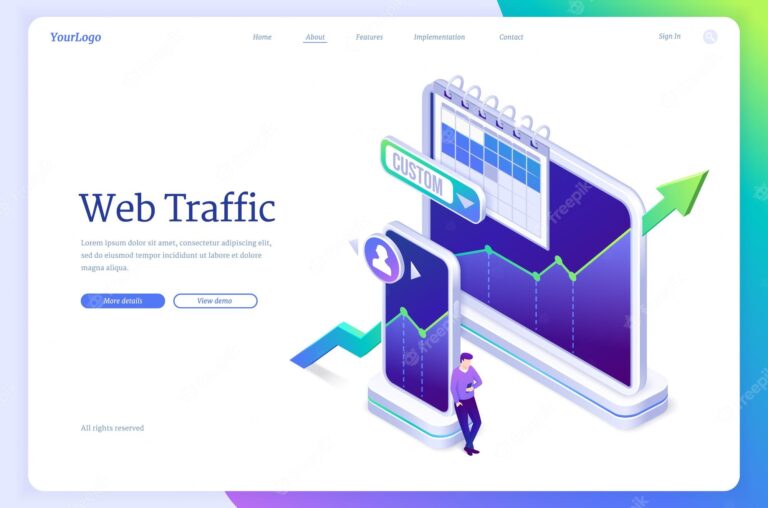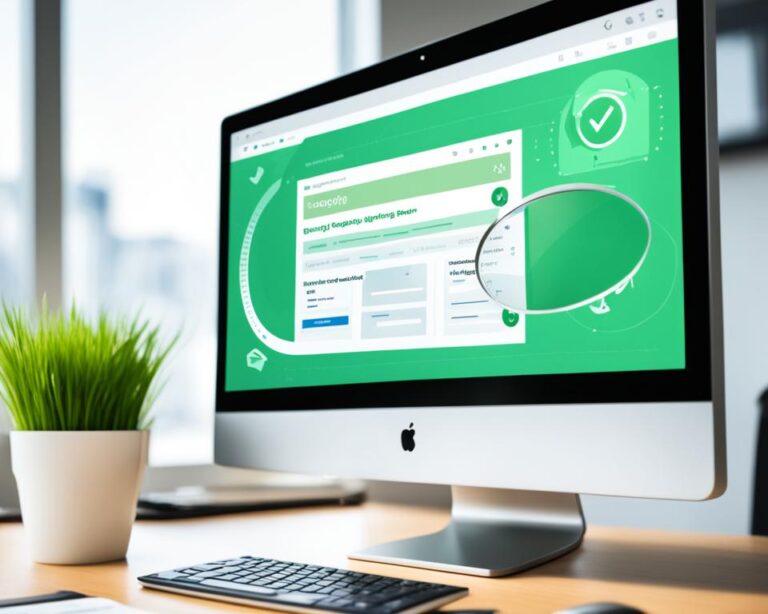Are you looking to improve your website rankings and attract more organic search traffic? Have you ever wondered how SEO optimization can be the key to unlocking your online success?
Did you know that organic search traffic accounts for a staggering 53.3% of all website traffic? That means more than half of the visitors to websites come from unpaid search engine results!
Key Takeaways:
- Organic search traffic constitutes over 50% of all website visitors.
- SEO optimization is essential for increasing organic search traffic.
- Understanding the benefits and downsides of organic traffic can help you make informed decisions.
- Key areas to focus on include keyword research, content creation, technical SEO, and link building.
- By implementing effective strategies and consistently monitoring your organic traffic, you can achieve online success.
Understanding Organic Traffic vs. Paid Traffic
When it comes to website traffic, there are two primary sources: organic traffic and paid traffic. It’s important to understand the differences between these two types and how they can impact your online presence.
Organic Traffic:
Organic traffic refers to the visitors that come to your website through unpaid search engine results. These are the users who find your website by typing relevant keywords into a search engine and clicking on the organic search results. Organic traffic can be further classified into three categories:
- Direct Traffic: This is when users visit your website by directly entering the URL into their browser.
- Referral Traffic: Referral traffic occurs when users click on a link to your website from another website.
- Social Traffic: Social traffic refers to visitors who come to your website through social media platforms.
Organic traffic is highly valuable because it is free and can generate a large volume of clicks without incurring direct costs. It helps increase your website’s visibility in search engine results, drives targeted traffic, and establishes credibility with users.
Paid Traffic:
Paid traffic, on the other hand, refers to visitors who come to your website through pay-per-click (PPC) ads. These ads are displayed on search engine results pages (SERPs) and other websites, and you pay for each click on your ad. Paid traffic can be an effective way to generate immediate visibility and reach a targeted audience. However, it can be costly depending on your budget and the competitiveness of the keywords you’re targeting.
To illustrate the difference between organic and paid traffic, let’s take a look at the following table:
| Type of Traffic | Description | Cost |
|---|---|---|
| Organic Traffic | Visitors from unpaid search engine results | No direct cost |
| Paid Traffic | Visitors from pay-per-click ads | Incurs cost for each click |
As you can see, organic traffic doesn’t require direct expenditure, while paid traffic involves paying for each click on your ad. This table provides a clear overview of the differences between the two traffic types.
Understanding the distinction between organic and paid traffic is crucial for developing an effective digital marketing strategy. By optimizing your website for organic search traffic and leveraging paid traffic strategically, you can maximize your online visibility and reach your target audience efficiently.
In the next section, we will explore the benefits and downsides of organic traffic, providing further insights into its value for your online presence.
Benefits and Downsides of Organic Traffic
Organic traffic has both advantages and disadvantages. Understanding these can help you make informed decisions about your website’s traffic strategy.
Advantages of Organic Traffic
- Free Traffic: Unlike paid advertisements, organic traffic comes at no direct cost to you. This allows you to invest your budget in other important areas of your business.
- Relevant Traffic: Organic search results are tailored to match the intent of the user’s search query. This means that when someone finds your website through organic search, they are more likely to be genuinely interested in your content or offerings.
- Global Reach: Organic search results can be accessed by users from all around the world. This enables you to reach a wider audience and expand your brand’s visibility on a global scale.
- Scalability with Content/SEO Strategy: With a well-executed content and SEO strategy, organic traffic has the potential for significant scalability. By consistently creating high-quality, optimized content, you can attract more organic visitors over time.
- Building Credibility: Showing up on the top pages of search engine results enhances your website’s credibility and authority in your industry. Users tend to trust websites that appear organically in their search results.
As you can see, organic traffic offers several key benefits that can contribute to the growth and success of your website.
Disadvantages of Organic Traffic
- Slower Growth Compared to Paid Traffic: Unlike paid traffic, which can generate immediate results, organic traffic growth may take time. Ranking higher in search engine results can require continuous optimization and patience.
- Not Every Search Ends in a Click: While appearing in organic search results is important, not every search results in a click to your website. Users may find the information they need directly in the search results, reducing the click-through rate.
- Investments in SEO and Content Creation: To attract organic traffic, you need to invest in a solid SEO strategy and create high-quality content. This requires time, effort, and potentially financial resources to optimize your website and produce valuable content.
Despite these disadvantages, the value of organic traffic is undeniable. It provides a steady stream of relevant visitors who are more likely to convert into leads or customers.
Having a clear understanding of the benefits and downsides of organic traffic is crucial for making informed decisions about your website’s traffic acquisition strategy.
Key Areas to Increase Organic Traffic
To increase organic traffic and boost your website’s visibility, it is essential to focus on key areas of your SEO strategy: keyword research, content creation and optimization, technical SEO, and link building.
Keyword Research
Keyword research plays a crucial role in driving targeted organic traffic to your website. By identifying relevant search queries, you can tailor your content to meet the needs and interests of your target audience. A comprehensive analysis of high-volume and long-tail keywords helps you uncover valuable opportunities to rank higher in search engine results.
Content Creation and Optimization
Creating high-quality, valuable content is essential for improving your website’s organic search rankings. By producing informative and engaging content that aligns with your target audience’s intent, you can attract more organic traffic. Incorporate relevant keywords naturally within your content, optimize meta tags (including title tags and meta descriptions), and make your content easily shareable to maximize its reach and impact.
Technical SEO
Technical SEO focuses on optimizing the technical aspects of your website to enhance its visibility and crawlability by search engines. This includes improving website speed, optimizing URL structure, fixing broken links, and implementing schema markup. By addressing technical SEO issues, you can ensure that search engines can effectively index and understand your site’s content, leading to increased organic traffic.
Link Building
Link building is a vital component of your SEO strategy and helps increase your website’s authority and visibility. By obtaining high-quality backlinks from reputable websites, you can enhance your website’s credibility in the eyes of search engines. Develop relationships with industry influencers, engage in guest blogging, and create valuable content that naturally attracts links from authoritative sources.
By focusing on these key areas of your SEO strategy, you can effectively increase organic traffic to your website and improve its overall visibility in search engine rankings.

Remember, organic traffic is crucial for long-term success and sustainability as it drives targeted visitors to your site without incurring direct costs. So invest your time and effort in implementing these strategies to establish a strong online presence and attract relevant organic traffic.
Steps to Increase Organic Traffic
To boost your organic search traffic effectively, you need to implement a solid SEO strategy that covers various aspects of optimization. Here are three specific steps that will help you increase your organic traffic:
-
Conduct a Technical SEO Audit
A technical SEO audit is a comprehensive analysis of your website’s technical foundation. It helps identify and fix any issues that may be hindering your site’s performance and visibility in search engine results. By conducting a thorough audit, you can ensure that your website meets the technical requirements set by search engines, thus improving its chances of ranking higher.
-
Perform Keyword Research
Keyword research is a crucial step in driving your SEO strategy. By identifying the right target keywords, you can optimize your website’s content to align with user search intent. Use keyword research tools to discover relevant keywords with high search volumes and low competition. By incorporating these keywords strategically into your content, you can increase your chances of ranking higher in search engine results.
-
Set Up a Google Business Profile
Setting up a Google Business Profile is essential for local SEO and appearing in local search results. It allows you to provide accurate and up-to-date information about your business, such as contact details, opening hours, and customer reviews. By optimizing your Google Business Profile and ensuring its consistency across various online directories, you can enhance your online visibility and attract more local organic traffic.
By following these steps and incorporating them into your SEO strategy, you can increase your organic traffic and improve your website’s rankings in search engine results, ultimately driving more visibility and success for your business.
Checking Organic Traffic
To ensure your website is effectively attracting organic traffic, it’s important to regularly check and analyze your organic traffic statistics. By utilizing tools like Google Analytics, Google Search Console, and Semrush Organic Research, you can gain valuable insights into the performance of your organic search efforts.
Google Analytics
One of the most widely used analytics platforms is Google Analytics. This powerful tool provides website owners with in-depth data on various metrics, including organic traffic. By verifying your website ownership and implementing the tracking code, you’ll be able to access comprehensive reports on the organic traffic your website receives. This data can help you identify trends, track the effectiveness of your SEO optimization efforts, and make informed decisions to improve your organic search performance.
Google Search Console
Another valuable tool for checking organic traffic is Google Search Console. With the “Search results” report in Google Search Console, you can gain insights into the search queries that are driving organic traffic to your website. This report provides information on impressions, clicks, click-through rates, and average position in search results. By understanding which keywords are performing well and driving traffic, you can optimize your SEO strategy and refine your content to attract even more organic visitors.
Semrush Organic Research
Semrush Organic Research is a comprehensive tool that allows you to uncover organic keyword rankings and estimate the organic traffic of any website. With Semrush, you can gain valuable insights into your competitors’ organic search performance and identify opportunities to boost your own organic traffic. By analyzing keyword rankings, search volumes, and traffic estimations, you can refine your SEO strategy and implement tactics to outrank your competition.
“Regularly checking your organic traffic statistics is essential to understand the effectiveness of your SEO efforts and identify areas for improvement. Utilizing tools like Google Analytics, Google Search Console, and Semrush Organic Research can provide valuable insights and help you optimize your website’s organic search performance.”
By leveraging the power of these tools, you can gain a deeper understanding of your website’s organic traffic patterns, identify opportunities for improvement, and refine your SEO strategy to drive even more organic visitors to your site.
Now that you know how to check your organic traffic, let’s explore some strategies to improve your organic search optimization in the next section.

Strategies to Improve Organic Search Optimization
To improve organic search optimization and drive more traffic to your website, it’s essential to focus on several key strategies. By implementing these tactics, you can enhance your website’s visibility, attract more targeted traffic, and improve search engine rankings.
1. Define a Comprehensive Keyword List
One of the first steps towards improving organic search optimization is to define a comprehensive keyword list. This involves analyzing the traffic and competition for each keyword to identify the most relevant and valuable keywords for your website.
2. Target Keywords That Match Search Intent
When creating content, it’s crucial to target keywords that align with the search intent of your target audience. Understanding the specific needs and desires of your audience will enable you to tailor your content to provide the information they are searching for, increasing the chances of ranking well in search engine results.
3. Consider Low-Volume Keywords
While high-volume keywords might attract a larger audience, low-volume keywords can be equally valuable for driving focused and transactional traffic. By targeting these low-volume keywords that are relevant to your industry or niche, you can attract a highly engaged audience that is more likely to convert.
4. Focus on Quality Content
Creating high-quality content is essential for improving search rankings and attracting organic traffic. Ensure your content is informative, well-researched, and provides genuine value to your audience. By consistently delivering quality content, you can establish yourself as a trusted authority in your industry, leading to higher search engine rankings.
5. Build Topical Authority with Content Clusters
Building topical authority involves creating content clusters around main topics and interlinking them to establish expertise and relevance to search engines. By grouping related content together and linking internally, you can demonstrate to search engines that you have comprehensive knowledge on a topic, improving your website’s topical authority and overall search optimization.
By implementing these strategies, you can improve your organic search optimization, increase visibility in search engine results, and attract more targeted traffic to your website, leading to greater online success.
Refreshing Old Content and Removing Pages
Refreshing old content is a crucial aspect of your SEO strategy. Search engines consider recency as a ranking factor, so updating outdated pages can significantly improve your search rankings and attract more organic traffic.
When refreshing content, focus on making significant changes to ensure its relevance. This can include updating statistics, facts, and examples, as well as incorporating new insights or perspectives. By keeping your content up-to-date, you demonstrate your expertise and commitment to providing accurate information to your audience.
Another important aspect of improving your search rankings is removing low-value pages. These pages do not provide any value to your audience or site and can negatively impact your overall site performance. By identifying and removing these pages, you can streamline your website, improve site navigation, and enhance the user experience.
Remember, quality should always take precedence over quantity. It’s better to have a smaller number of high-quality, valuable pages than a large quantity of low-value pages. Search engines prioritize quality content, so focus on creating informative, engaging, and well-optimized pages that offer unique insights or solutions to your audience’s needs.
Let’s take a look at the benefits of refreshing old content and removing low-value pages:
| BENEFITS | DESCRIPTION |
|---|---|
| Improved Rankings | Updating outdated content and removing low-value pages can improve your search engine rankings and visibility. |
| Increased Relevance | Refreshing content ensures that it remains relevant and up-to-date, providing value to your audience. |
| Enhanced User Experience | By removing low-value pages, you improve site navigation and provide a better overall experience for your visitors. |
| Streamlined Website | Removing unnecessary pages helps simplify your website structure and make it easier for users to find valuable content. |
By refreshing old content and removing low-value pages, you prioritize quality over quantity and ensure that your website delivers the most valuable and relevant information to your audience.
Integration of Videos for Increased Dwell Time
Integrating videos on your website can significantly boost dwell time, leading to improved search engine rankings. Videos have the ability to captivate and engage visitors, resulting in longer site visits and increased user interaction.
When strategically placed within your content, videos complement textual information and create an immersive browsing experience. They enhance the overall user experience, making your website more appealing and memorable.
By incorporating videos, you can provide your audience with a dynamic and multi-sensory experience. The visual and auditory elements of videos not only convey information more effectively but also make it easier for users to understand and retain the message you want to convey.
Moreover, sharing videos on social media platforms and other channels can attract new audiences and referral traffic to your website. This influx of traffic, along with the increased dwell time on your site, contributes to improved search rankings in search engine results pages.
Optimizing Title Tags and Meta Descriptions
When it comes to attracting clicks and increasing organic traffic, optimizing title tags and meta descriptions is crucial. These components play a significant role as they are the first things users see in search results. To maximize your website’s visibility and click-through rate, it is essential to craft enticing headlines and concise meta descriptions that accurately represent your content.
By creating compelling title tags and meta descriptions, you can capture users’ attention and encourage them to click on your link. An enticing title tag sparks curiosity and entices users to learn more, while a concise meta description provides a quick summary of your content, giving users a clear understanding of what they can expect.
Enhancing Click-Through Rate
An optimized title tag and meta description can significantly impact your click-through rate (CTR). When users see engaging headlines and concise descriptions that align with their search queries, they are more likely to click on your link. A higher CTR indicates to search engines that your website provides valuable content, which can lead to improved search rankings and increased organic traffic.
Best Practices for Crafting Compelling Headlines and Descriptions
- Create enticing headlines that capture users’ attention and pique their curiosity. Use power words, incorporate relevant keywords, and make the benefit clear.
- Keep your meta descriptions concise, ideally under 160 characters, to ensure they appear fully in search results.
- Use action-oriented language to inspire users to take action and click on your link.
- Ensure that both your title tags and meta descriptions accurately reflect the content on your page. Misleading or irrelevant descriptions can frustrate users and harm your website’s credibility.
Example of an Optimized Title Tag and Meta Description
Music Lovers Rejoice: Discover the Best Headphones for Audiophiles | YourMusicBlog
Experience music like never before with our expert-curated list of the best headphones for audiophiles. Find your perfect match and elevate your audio journey today.
By implementing these strategies and ensuring that your title tags and meta descriptions are optimized, you can increase your website’s click-through rate and drive organic traffic. Remember, the first impression matters, so make it count with compelling headlines and concise descriptions.

Creating a Blog and Publishing Regularly
One of the most effective ways to increase organic traffic to your website is by creating a blog and publishing content regularly. Blogging not only allows you to engage with your target audience but also helps establish authority and build trust. By consistently publishing valuable content, you can attract more leads and drive organic traffic to your website.
Creating a blog provides you with a platform to showcase your expertise, share valuable insights, and connect with your audience. It allows you to establish yourself as an industry leader and demonstrate your knowledge and proficiency in your niche. This, in turn, helps build trust and credibility with your readers and potential customers.
Consistent publishing is key when it comes to blogging. Regularly updating your blog with fresh and informative content creates a sense of order and encourages readers to visit your site on a regular basis. This can lead to increased engagement, longer time spent on your website, and ultimately, more conversions.
“Consistent publishing of high-quality content is essential for building an online presence and attracting organic traffic to your website.”
By consistently publishing blog posts, you can also improve your search engine rankings. Search engines value fresh and relevant content, and regular blog updates signal to search engines that your website is active and provides valuable information. As a result, search engines are more likely to rank your website higher in search results, making it more visible to potential visitors.
In addition to improving your website’s visibility and attracting organic traffic, blogging also provides an opportunity to engage with your audience through comments and social media. Encouraging reader interaction and responding to comments helps foster a sense of community and builds stronger relationships with your audience.
Remember to optimize your blog posts for search engines by incorporating relevant keywords, writing compelling meta descriptions, and using header tags effectively. By following these best practices, you can maximize the organic traffic potential of your blog and increase your website’s authority in your industry.
| Benefits of Creating a Blog and Publishing Regularly: |
|---|
| Establish authority and trust |
| Reach your target audience |
| Increase website visibility |
| Attract organic traffic |
| Build relationships with your audience |
Conclusion
Increasing organic search traffic requires a comprehensive SEO strategy that includes keyword research, content optimization, technical SEO, and link building. By following best practices and consistently publishing high-quality content, you can improve your website rankings and attract more organic traffic.
Keyword research is essential to identify the search queries that your target audience is using. By strategically incorporating these keywords into your website content, you can increase your visibility in search engine results and drive more organic traffic to your site.
Content optimization involves creating relevant and engaging content that meets the needs of your audience. By producing high-quality articles, blog posts, and other informative content, you can establish your expertise in your industry and attract more visitors to your website.
Technical SEO ensures that your website is optimized for search engine crawlers, making it easier for them to index your pages. By improving your website’s technical aspects such as page load speed, mobile responsiveness, and URL structure, you can enhance its visibility in search results and attract more organic traffic.
Finally, link building plays a crucial role in improving your website’s authority and visibility. By obtaining high-quality backlinks from reputable websites, you can demonstrate to search engines that your content is valuable and trustworthy, leading to higher rankings and increased organic traffic.
This article has provided actionable tips and strategies to effectively boost your organic search traffic and achieve online success. By implementing these strategies and continuously refining your SEO approach, you can drive more organic traffic to your website, increase your online visibility, and ultimately grow your business.







